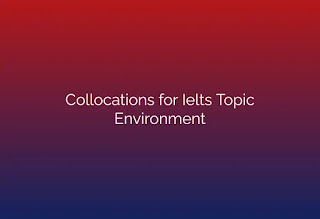| Collocation | Meaning | Example |
|---|---|---|
| Environmental degradation | the process by which natural environments are damaged or destroyed | The Environmental degradation caused by industrial pollution is a major concern. |
| Carbon footprint | the total amount of greenhouse gases produced by an individual, organization, or community | The company has set a goal to reduce its Carbon footprint by 50% by the end of the year. |
| Climate change | a long-term change in the average weather patterns on Earth | Climate change is causing rising sea levels and more extreme weather events. |
| Renewable energy | energy sources that are replenished naturally and do not deplete finite resources | Solar and wind power are examples of Renewable energy sources. |
| Habitat destruction | the destruction or damage of an animal or plant's natural environment | The construction of a new housing development is causing Habitat destruction for the local wildlife. |
| Sustainable development | development that meets the needs of the present without compromising the ability of future generations to meet their own needs | The government's plan for sustainable development includes investing in renewable energy and protecting natural habitats. |
| Carbon emissions | the release of carbon dioxide and other greenhouse gases into the atmosphere | The use of fossil fuels is a major source of Carbon emissions. |
| Water scarcity | a lack of access to clean and safe water | Water scarcity is a major problem in many developing countries. |
| Ozone depletion | the reduction of the ozone layer in the upper atmosphere | The use of certain chemicals, such as chlorofluorocarbons, can lead to Ozone depletion. |
| Ecological footprint | the impact of human activities on the natural environment | The average person's ecological footprint is much larger than it needs to be. |
| Ecosystem services | the benefits that people derive from natural ecosystems | Ecosystem services such as water purification and air purification are essential to human well-being. |
| Resource depletion | the use of resources at a rate that cannot be sustained | Fossil fuel consumption is leading to Resource depletion. |
| Plastic pollution | the presence of plastic in the environment, often in the form of litter | Plastic pollution is a major problem in oceans and coastal areas. |
| Sustainable consumption | consuming goods and services in a way that preserves the environment and natural resources | Sustainable consumption involves making choices that reduce the environmental impact of consumption. |
| Greenhouse gas emissions | the release of gases such as carbon dioxide and methane into the atmosphere, which trap heat and contribute to climate change | Greenhouse gas emissions from the transportation sector are a major contributor to climate change. |
| Habitat fragmentation | the division of natural habitats into smaller, isolated areas | Habitat fragmentation caused by urban development can make it difficult for animals to find food and mates. |
| Environmental sustainability | the practice of using resources in a way that preserves the environment for future generations | Environmental sustainability is becoming increasingly important as the population grows and resources become scarce. |
| Green infrastructure | a network of natural and semi-natural areas that provide environmental benefits such as carbon sequestration, air and water purification, and wildlife habitat | Green infrastructure, such as urban parks and green roofs, can help mitigate the effects of urbanization. |
| Water conservation | the practice of using water resources efficiently and responsibly | Water conservation measures, such as low-flow showerheads and rain barrels, can help reduce water usage and save money on utility bills. |
| Air pollution | the presence of harmful substances in the air that can have negative impacts on human health and the environment | Air pollution from industrial emissions and transportation is a major concern in many cities around the world. |
Popular
Recents
[getWidget results='3' label='recent' type='list']
Comments
[getWidget results='3' label='comments' type='list']
Subscribe Us
Smartphones
[getWidget results='3' label='Smartphones' type='list']


0 Comments
Post a Comment